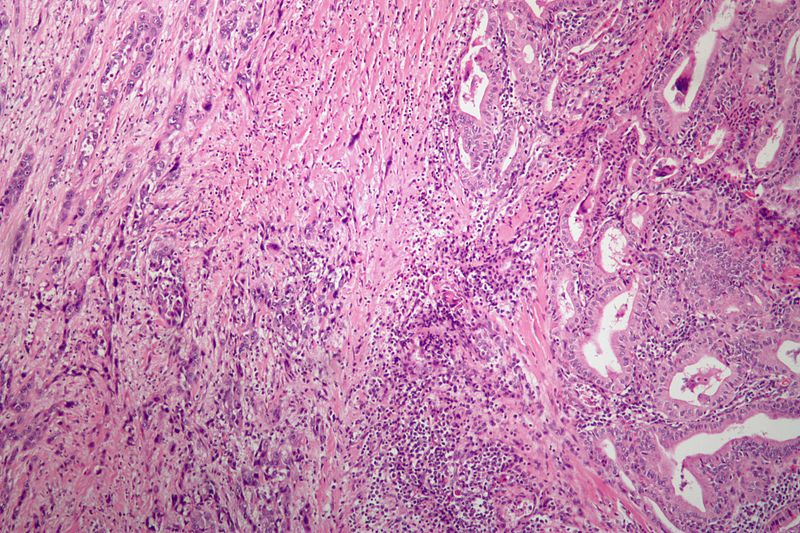Anaplastic thyroid cancer pathophysiology: Difference between revisions
No edit summary |
No edit summary |
||
| Line 6: | Line 6: | ||
==Pathogenesis== | ==Pathogenesis== | ||
* Anaplastic tumors have a high mitotic rate and lymphovascular invasion. It rapidly invades surrounding tissues (such as the [[trachea]]). | * Anaplastic tumors have a high mitotic rate and lymphovascular invasion. It rapidly invades surrounding tissues (such as the [[trachea]]). | ||
* Most [[patients]] with anaplastic thyroid cancer have distant [[metastasis]] at the time of [[diagnosis]] because of the rapid growth and aggressive nature of this type of [[cancer]]. | |||
* Common sites of [[metastasis]] include the [[lungs]], [[pleura]], [[bones]], and [[brain]]. | |||
==Genetics== | ==Genetics== | ||
* Anaplastic thyroid cancer has been associated with the following genetic mutations:<ref name="pmid16735986">{{cite journal| author=Patel KN, Shaha AR| title=Poorly differentiated and anaplastic thyroid cancer. | journal=Cancer Control | year= 2006 | volume= 13 | issue= 2 | pages= 119-28 | pmid=16735986 | doi= | pmc= | url=http://www.ncbi.nlm.nih.gov/entrez/eutils/elink.fcgi?dbfrom=pubmed&tool=sumsearch.org/cite&retmode=ref&cmd=prlinks&id=16735986 }} </ref> | * Anaplastic thyroid cancer has been associated with the following genetic mutations:<ref name="pmid16735986">{{cite journal| author=Patel KN, Shaha AR| title=Poorly differentiated and anaplastic thyroid cancer. | journal=Cancer Control | year= 2006 | volume= 13 | issue= 2 | pages= 119-28 | pmid=16735986 | doi= | pmc= | url=http://www.ncbi.nlm.nih.gov/entrez/eutils/elink.fcgi?dbfrom=pubmed&tool=sumsearch.org/cite&retmode=ref&cmd=prlinks&id=16735986 }} </ref><ref name="pmid15880523">{{cite journal |vauthors=Quiros RM, Ding HG, Gattuso P, Prinz RA, Xu X |title=Evidence that one subset of anaplastic thyroid carcinomas are derived from papillary carcinomas due to BRAF and p53 mutations |journal=Cancer |volume=103 |issue=11 |pages=2261–8 |date=June 2005 |pmid=15880523 |doi=10.1002/cncr.21073 |url=}}</ref> | ||
** | ** [[TP53]] | ||
** BRAF | ** [[BRAF]] | ||
==Associated Conditions== | ==Associated Conditions== | ||
* Anaplastic thyroid cancer may be associated with the following [[conditions]]: | * Anaplastic thyroid cancer may be associated with the following [[conditions]]: | ||
* [[Papillary thyroid cancer]] | ** [[Papillary thyroid cancer]] | ||
==Gross Pathology== | ==Gross Pathology== | ||
* Unencapsulated, fleshy, tan-white tumor | * Macroscopic features of anaplastic thyroid cancer include: | ||
* Soft-tissue infiltration of the neck | ** Unencapsulated, fleshy, tan-white [[tumor]] | ||
** Soft-tissue infiltration of the neck | |||
==Microscopic Pathology== | ==Microscopic Pathology== | ||
* Three types of histologic variety | * Three types of histologic variety will be expected in anaplastic thyroid cancer: | ||
:* Spindle | :* Spindle cell | ||
:* Giant cell | :* Giant cell | ||
:* Squamoid cell | :* Squamoid cell | ||
Features: | * Features include: | ||
*Cytologically malignant: | ** Cytologically malignant: | ||
**Huge nuclear-cytoplasmic ratio | ** Huge nuclear-cytoplasmic ratio | ||
**Mitoses | ** Mitoses | ||
* Presence or absence of [[necrosis]] | ** Presence or absence of [[necrosis]] | ||
==Immunohistochemistry== | ==Immunohistochemistry== | ||
* Anaplastic thyroid cancer may be positive for the following markers: | * Anaplastic thyroid cancer may be positive for the following markers: | ||
Latest revision as of 16:52, 8 October 2019
|
Anaplastic thyroid cancer Microchapters |
|
Differentiating Anaplastic thyroid cancer from other Diseases |
|---|
|
Diagnosis |
|
Treatment |
|
Case Studies |
|
Anaplastic thyroid cancer pathophysiology On the Web |
|
American Roentgen Ray Society Images of Anaplastic thyroid cancer pathophysiology |
|
Risk calculators and risk factors for Anaplastic thyroid cancer pathophysiology |
Editor-In-Chief: C. Michael Gibson, M.S., M.D. [1]; Associate Editor(s)-in-Chief: Ammu Susheela, M.D. [2]
Overview
Anaplastic thyroid cancer arises from cells of the thyroid, which are normally involved in production and secretion of thyroid hormones, thyroxine (T4) and triiodothyronine (T3). Anaplastic thyroid tumor is always considered as stage IV. Genes involved in the pathogenesis of follicular thyroid cancer include P53 and BRAF.
Pathogenesis
- Anaplastic tumors have a high mitotic rate and lymphovascular invasion. It rapidly invades surrounding tissues (such as the trachea).
- Most patients with anaplastic thyroid cancer have distant metastasis at the time of diagnosis because of the rapid growth and aggressive nature of this type of cancer.
- Common sites of metastasis include the lungs, pleura, bones, and brain.
Genetics
Associated Conditions
- Anaplastic thyroid cancer may be associated with the following conditions:
Gross Pathology
- Macroscopic features of anaplastic thyroid cancer include:
- Unencapsulated, fleshy, tan-white tumor
- Soft-tissue infiltration of the neck
Microscopic Pathology
- Three types of histologic variety will be expected in anaplastic thyroid cancer:
- Spindle cell
- Giant cell
- Squamoid cell
- Features include:
- Cytologically malignant:
- Huge nuclear-cytoplasmic ratio
- Mitoses
- Presence or absence of necrosis
Immunohistochemistry
- Anaplastic thyroid cancer may be positive for the following markers:
- Pankeratin (AE1/AE3)
- High molecular weight keratins
- TTF-1
- PAX8
- P53
- B-catenin
-
Anaplastic thyroid carcinoma with a component of PTC. (WC)
References
- ↑ Patel KN, Shaha AR (2006). "Poorly differentiated and anaplastic thyroid cancer". Cancer Control. 13 (2): 119–28. PMID 16735986.
- ↑ Quiros RM, Ding HG, Gattuso P, Prinz RA, Xu X (June 2005). "Evidence that one subset of anaplastic thyroid carcinomas are derived from papillary carcinomas due to BRAF and p53 mutations". Cancer. 103 (11): 2261–8. doi:10.1002/cncr.21073. PMID 15880523.
